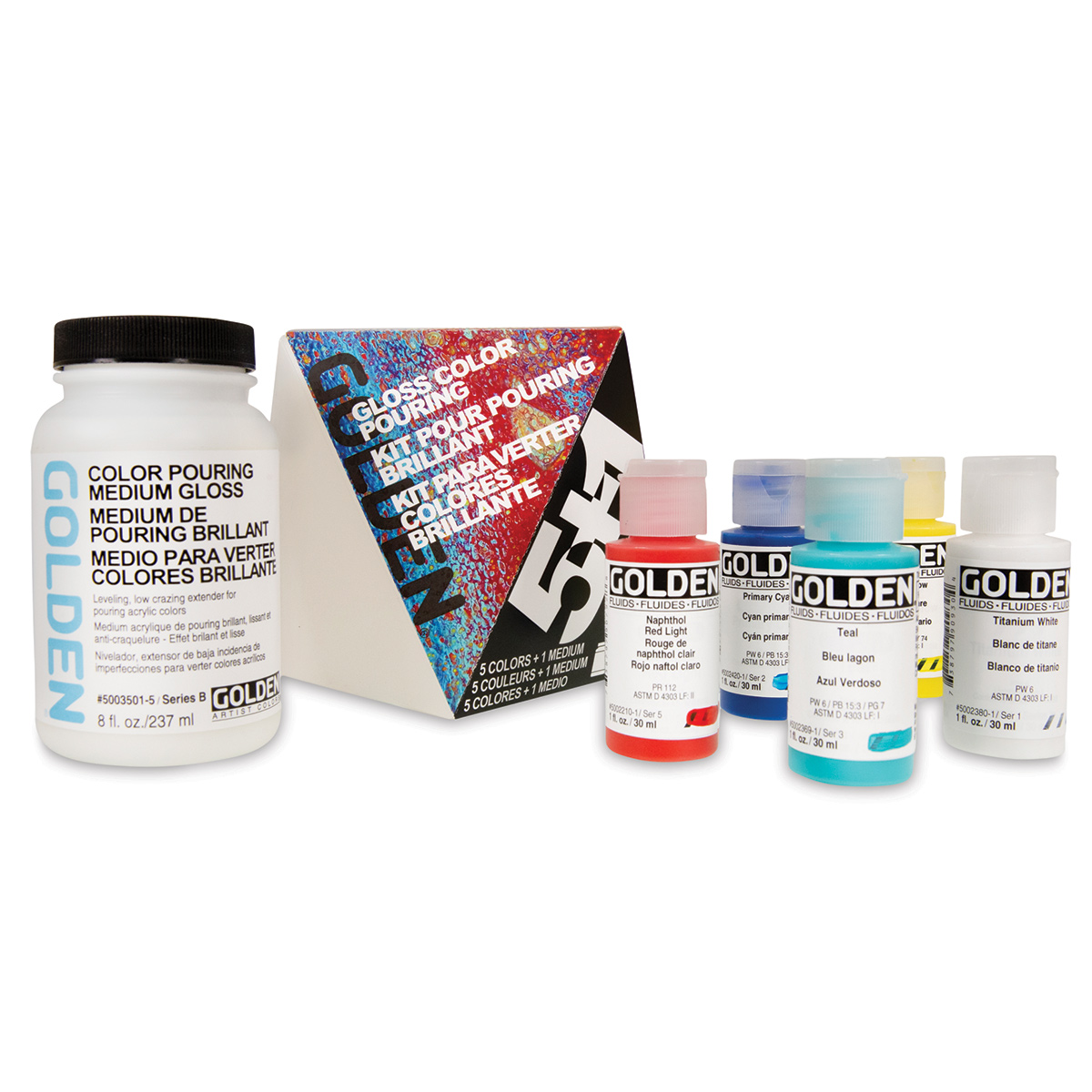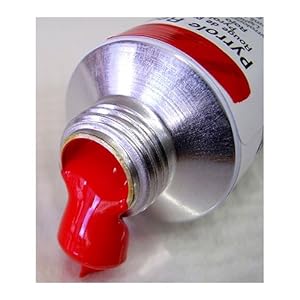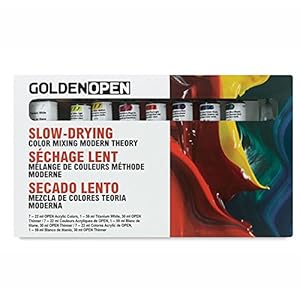Description
Update 2020: Since I wrote the original article, Golden has released Golden Color Pouring Medium, which is very similar to GAC 800 and has many of the same characteristics.
In this review, I will first explain what a pouring medium is. Then I will examine the things that I like and don’t like about Golden GAC 800 and Golden Pouring Medium. I will also list an alternative product that can be used.
What is pouring medium for acrylic paint?
Many techniques are possible with modern acrylic paints. Many of these techniques were not possible for artists living in the past. The difference is that acrylic paint is very flexible and can be mixed with water. This lends itself to a huge diversity of applications. One technique that is becoming more and more popular is pouring acrylic paint. This idea has evolved from the days that Jackson Pollock was dripping black stovepipe enamel onto huge rolls of canvas. Today any color and transparency can be dripped, drizzled, pooled, and poured onto all kinds of different surfaces. Some of the surfaces that can be poured on include raw or primed canvas, paper, wood, metal, and composite panels. This allows the artist to create all kinds of special effects that can look truly unique.

Golden Pouring Mediums – $29.40
from: Blick Art Materials
One problem that many artist who have experimented with pouring acrylic paint have run into is crazing. Crazing occurs when, the surface of the poured layer dries quicker than the rest of the paint. Because acrylic paint shrinks as it dries, this upper layer become smaller than the layers below it. This causes the upper layer to split, fissure, or crack. This splitting or cracking is also known as crazing.
Often artists will add regular acrylic polymer medium or water to their paint, in order to make it easier to pour. Unfortunately, they will quickly realize two problems with this. If they use too much water the paint will mix and soak into the surface as it dries, and it will end up looking nothing like what it looked like when they poured it. If they use a normal medium that isn’t really designed for pouring it can have a tendency to craze.
This is where pouring mediums come in. Pouring mediums are specially designed to dry evenly and avoid the crazing surface problem. They are also usually quite thin, so paint can be mixed with them and easily poured onto a surface.
Golden GAC 800, Golden Pouring Medium
Golden makes a line of specialty acrylic polymers that can be added to their main line of products. One of these products is called Golden Pouring Medium. This is Golden’s version of a pouring medium. I have gone through a lot of this stuff, and I used to by several gallon jugs of it at one time. Golden GAC 800 comes in 8oz., 16 oz., 32 oz., and (my favourite) 1 gallon sizes.
The product is quite liquidy and is a white color when wet. It dries to clear. The easiest way to add color to Golden GAC 800 is to use Golden Liquid Acrylics. Golden Liquid Acrylics have the same pigment load as regular Golden Heavy Body Acrylics but they are in the form of a much thinner liquid. This thinner liquid is almost the same consistency as the pouring medium. This means that it mixes quite easier. Regular acrylic paint can be mixed with it as well, but because it is thicker, it tends to clump up, and care needs to be taken to ensure that it is mixed thoroughly.

When Golden Pouring Medium is poured onto your canvas it will tend to level-itself off, with the excess running off of the edges of the surface. You should plan for this happening by using it over a surface that you do not mind getting dirty. This is because once it dries, it can be quite difficult to remove. (I have found this out the hard way, after using it over a bare concrete floor). Another way to control the medium and prevent it from running off is to tape the outside edges of the surface to create a barrier. This barrier will hold the Golden GAC 800 on the surface and prevent it from dripping off. Ensure that the barrier is quite strong, as the weight of the material can easily displace weaker barriers. When I use it, I wrap multiple layers of masking tape around the canvas to ensure strength. One thing to keep in mind if you use a barrier, is that this can cause the layer of medium to be thicker. When it is thicker, it is more likely to skin and craze, so care should be taken to slow drying as much as possible.
What we like about it
Some of the things that we like about Golden Pouring Medium is how versatile it can be. It can be used over many different types of surfaces. It can also be poured over objects that have been placed on the canvas to create unique textures. Different colors of pouring medium can be poured into each other to create interesting swirling effects. It can also be manipulated with brushes, sticks, or even gloved hands to create all kinds of unique looks. More precise images and thinner lines can be created by dripping the paint from a stick or brush. It can also be put into a squeeze bottle for even more control. These thinner lines can be poured directly onto a dry surface or into a layer or a still-wet contrasting color of pouring medium.
We also like the smooth, even, glossy surface that this product dries to. And if you are working on large or multiple pieces, you will appreciate the large one gallon jugs that it comes in.
It is also quite compatible with other Golden acrylic products. I have used it with Golden Acrylic Flow-Release to achieve some pretty cool effects. Flow release is used in very small quantities to break the surface tension of the liquid acrylic. This changes the way it flows and mixes when it is poured. If you decide to use a Golden Acrylic Flow Release, then make sure that you don’t use more than the amount that is suggested on the label. If too much is used it can cause problems with the strength of the acrylic paint film.
What we don’t like about it
This is a truly great project, and I have created dozens of paintings with it. There are a few downsides that you should consider when you use it. The first is that because the product is white-ish when wet, and dries clear, the color of your painting can change considerably as it dries. The white of the wet medium lightens the product when it is wet. As it dries the white disappears so the painting will get darker. On more than one occasion I have poured vibrant pastel coloured pieces, only to have them dry much darker. This can be avoided by testing your mixes ahead of time, to see how they will dry. You can also add a bit of white to lighten everything. Or you can do as I eventually did, and adjust your colors to be several steps lighter, and expect that the will dry darker. Do this by using less pigmented paint with the medium. So if you want it to be a medium green when dry, when you pour it, it should be a much lighter green. This takes some trial and error to determine exactly how much darker it will get.
Another problem is that if it is used thickly or in really dry environments it can still tend to craze. I spoke to Golden’s tech support about this issue, and they suggested increasing the humidity around the painting to slow down the drying. It is when it dries to quick that it forms a skin. You need a slow even drying for it to work. I remedied this by building a small tent of plastic sheet over (but not touching) the wet canvasses that were lying flat on the floor. This tent allowed a small amount of fresh air in, but slowed down the drying considerably (sometimes for several days on thicker pourings)
Another issue that I ran into is that the product is just slightly thicker then I would like it to be. If it was just a tiny bit thinner, I think that it would pour even easier. I usually remedied this by thoroughly stirring a tiny bit of water into it. This made it slightly more liquidy and the perfect pouring consistency. The risk of adding any water to it though is that it will weaken its resistance to crazing. So if you do add water, either try not to use it to thickly, or find a way to slow down the drying so that it dries evenly.
What other pouring mediums are there?
There is another pouring medium on the market and it is made by Liquitex. Liquitex Professional Pouring Effects Medium is very similar to the Golden pouring medium in many regards. It is designed to prevent the surface from crazing and to be mixed with regular acrylic paint. One advantage to the Liquitex Pouring Medium is that it is a bit thinner of a consistency. This means that it is a bit runnier and flows a little bit easier. In my case it meant that I didn’t need to add any water to achieve the effect that I wanted.

Golden Pouring Mediums – $29.40
from: Blick Art Materials
Golden GAC 800 Review
Golden Pouring Medium is a great product if you are looking for an acrylic pouring medium. It will allow you to create all kinds of cool effects and try different techniques. Most importantly it will help to prevent the occurrence of crazing in your poured painting.








Reviews
There are no reviews yet.